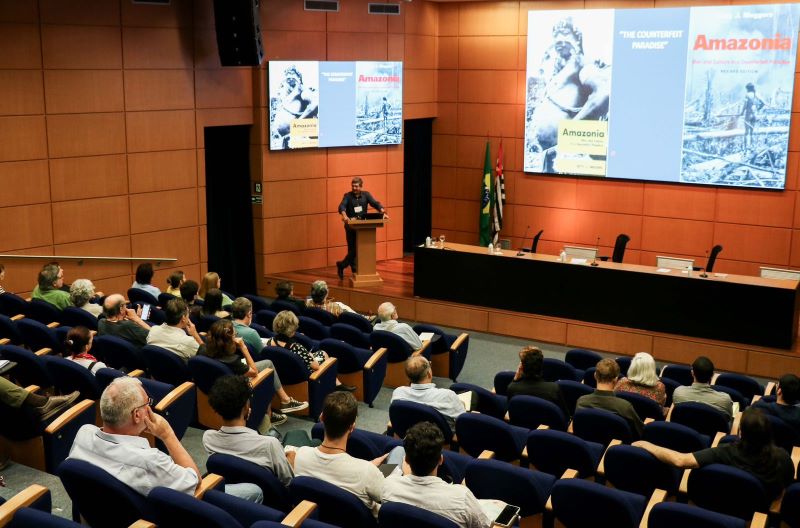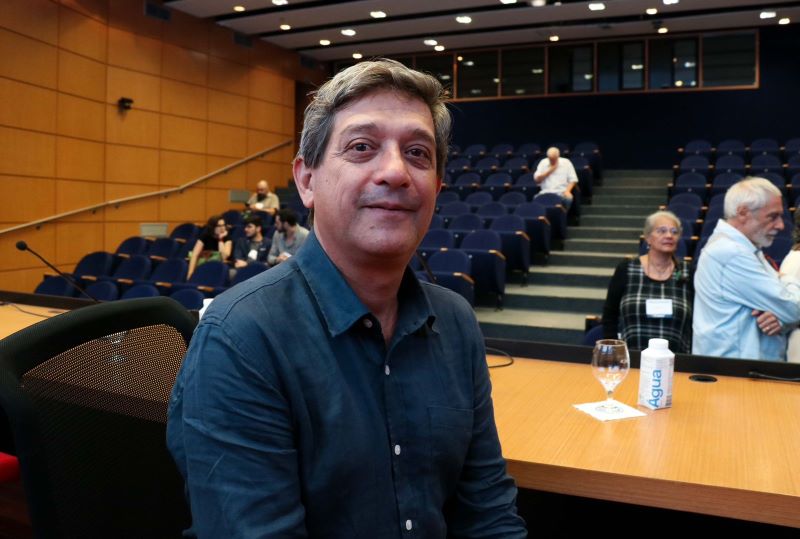


The second FAPESP Lecture 2024 took place on March 22 (photo: Daniel Antônio/Agência FAPESP)
Published on 04/01/2024
By José Tadeu Arantes | Agência FAPESP – The idea that in the remote past the Amazon was practically unpeopled and that this vast region was inhabited only by a few small Indigenous communities without the riches of the Andean civilizations has been definitively refuted by recent findings revealing an abundance of material resources, roads, cities and large populations across ancient Amazonia.
“The human presence in the Amazon dates from over 8,000 years ago. Evidence of settlements that existed 13,000 years ago has been found in some places. At the start of the fifteenth century, before the Europeans came, the total population of the region can be estimated at some 10 million,” said Eduardo Neves, professor of Brazilian archeology at the University of São Paulo and director of its Museum of Archeology and Ethnology (MAE-USP).

Eduardo Neves, director of the University of São Paulo’s Museum of Archeology and Ethnology (photo: Daniel Antônio/Agência FAPESP)
Neves is a key figure in New Archeology and one of the leading proponents of the major revision that changed the paradigm of research on the Amazon’s past. On March 24, he delivered the second FAPESP Lecture 2024, entitled “There’s something new in the past: the state of the art in archeological research on the Amazon”.
“We’ve discovered several things in recent years that have changed our understanding of the Amazon’s past. First, Indigenous people have lived there for a very long time. Second, the region was an independent center for domestication and cultivation of plants, and it had more than one independent center of pottery production. Third, occupation by these people transformed the landscape and produced abundance. Fourth, population growth led to cultural diversity and organization. We now know there were cities in the Amazon – in at least three or four different contexts,” Neves said.
Remains of these cities hidden by dense forest are being excavated by Neves and his team, and were also recently detected by airborne remote sensing surveys using LIDAR, in which laser light pulses scan Earth’s surface and can provide data from objects under the forest canopy. An article on this study, which was conducted by Stéphen Rostain and collaborators, was published in January as a cover feature in the journal Science.
According to the article, the core area of Kilamope, one of the settlements in Ecuador, is as large as Egypt’s Giza Plateau or the main avenue of Teotihuacan in Mexico, for example. The Amazonian landscape was largely shaped by human activity, Neves said.
The Amazon region is estimated to contain some 390 billion trees belonging to 16,000 different species, only 1.4% of which (227 species) account for almost half of all the trees. This phenomenon is known as species hyperdominance and is clearly due to human management. “Six of the ten most hyperdominant species are palms, and the most hyperdominant of all is açaí [Euterpe oleracea],” he said.
Land use management made the Amazon a center of agrobiodiversity with an abundance of crops such as corn, cassava, peanuts, Brazil nuts, sweet potatoes, peach palm (Bactris gasipaes), cocoa, pineapple, tobacco, coca, guarana, habanero pepper (Capsicum chinense), and many others. “The only evidence of rice domestication outside Asia and Africa is found in the Amazon,” Neves said.
An important aspect analyzed by Neves was the small number of cereals besides corn and rice in this wide array of species. “Cultivation of cereals imposes an annual rhythm of activity and the need to store harvested grain. In the case of roots and trees, the routines are much freer,” he said, associating the lack of dominance of cereal cultivation with the fact that no state apparatuses emerged in the Amazon.
Another point he stressed was that the Amazon had several independent centers of pottery production. “The oldest one we know about in the Americas was at a site called Taperinha, a river sambaqui [midden] near Santarém that has been dated to about 7,000 years ago,” he said.
The lecture was introduced by Esther Império Hamburger, a professor at the University of São Paulo’s School of Communications and Arts (ECA-USP) and moderated by Maria de Fátima Morethy Couto, a professor at the State University of (UNICAMP), who read a paragraph from Sob os Tempos do Equinócio: Oito mil anos de história na Amazônia central (“In Equinoctial Times: Eight Thousand Years of History in the Amazon”), a book authored by Neves and reported on by Agência FAPESP at the time of its publication (read more at: agencia.fapesp.br/39627).
A recording of the lecture “There’s something new in the past: the state of the art in archeological research on the Amazon” can be watched at: www.youtube.com/watch?v=AVch7yyWI8M.
Source: https://agencia.fapesp.br/51266